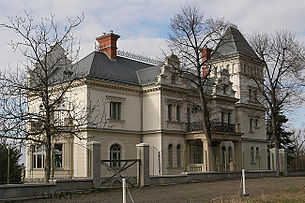Zebegény
| Zebegény | ||
|---|---|---|
| Town | ||

Palace of Zebegény
|
||
|
||
| Location of Zebegény | ||
| Coordinates: 47°47′51″N 18°54′36″E / 47.79757°N 18.90996°ECoordinates: 47°47′51″N 18°54′36″E / 47.79757°N 18.90996°E | ||
| Country |
|
|
| County | Pest | |
| Population (2007) | ||
| • Total | 1,204 | |
| • Density | 124.68/km2 (322.9/sq mi) | |
| Time zone | CET (UTC+1) | |
| • Summer (DST) | CEST (UTC+2) | |
| Postal code | 2627 | |
| Area code(s) | 27 | |
| Website | Municipality of Zebegény | |
Zebegény is a picturesque historic village in Pest county, Hungary. It is located 60 km north of Budapest in the Danube Bend, next to the Duna-Ipoly National Park. It is a favourite destination for tourists, who love the quiet and the fresh air. Due to its nice beaches, mountains, and forests, the village was nicknamed "The marble of the Danube Bend".
The town has a rich old history. By 1251 a Benedictine convent had been built in the valley of the Mill Creek. Records from the 8th century note the existence of the village. The first record of the village name dates from a letter of 1295, when it was called Zebeguen.
During the Árpádházi-age, a Benedictine Monastery in the Pécs-Baranya diocese was called Szöbegény. According to the archaeologistsrecor, the Benedictines moved from Szöbegény to here and recorded the place as Zebegény. A document dated 26 September 1295 calls the Benedictine Monastery the "Monasterium de Zebeguennak" (Monastery of Zebegény). In the memos of the monastery of Saint Martin, Zebegény is noted as officially founded in the Esztergom archdiocese.
In the late medieval ages, during the Turkish invasion, the village was almost destroyed. Zebegény and the area repelled the Turkish invasion around 1685. Later the population was reduced by plague.
During the 18th century, the Crown recruited German farmers to populate the areas decimated by the Ottomans and restore farming along the Danube. The Germans were allowed to keep their language and religion, and became part of the group known as Danouswabians. Numerous German, Hungarian and Slavic migrants settled in the village. Records from the 19th century mention Zebegény as a German-Hungarian-Slavic village.
Since the Hungarian economic transition period in the late twentieth century, the village has its own municipality. It also has an elementary school, kindergarten and a library.
Since the early 1990s, Zebegény has become a popular destination among the people of Budapest. The first villas and week-end houses were built at that time. Due to its extraordinary landscape, healthy, clean air and its historic houses, the town is a favourite week-end retreat among the Budapesters.
The cultural life (galleries, festivals, museums, sport facilities) of the village is extraordinary comparing to a normal village. Visitors can find here the Museum of István Szőnyi and the Sailing Museum of Vincze Farkas. The village organize a summer Open University of Arts since 1968. Furthermore, Zebegény has its own ski place, and a cycling route is crossing through the village.
...
Wikipedia


